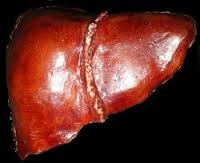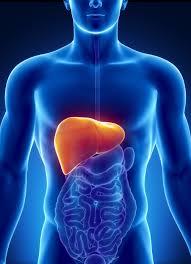The Liver and its anatomy and physiology:
Weighing in at around 3 pounds, the liver is the body’s second largest organ; only the skin is larger and heavier. The liver performs many essential functions related to digestion, metabolism, immunity, and the storage of nutrients within the body. These functions make the liver a vital organ without which the tissues of the body would quickly die from lack of energy and nutrients. Fortunately, the liver has an incredible capacity for regeneration of dead or damaged tissues.
The liver is a roughly triangular organ that extends across the entire abdominal cavity just inferior to the diaphragm. Most of the liver’s mass is located on the right side of the body where it descends inferiorly toward the right kidney. The liver is made of very soft, pinkish-brown tissues encapsulated by a connective tissue capsule. This capsule is further covered and reinforced by the peritoneum of the abdominal cavity, which protects the liver and holds it in place within the abdomen.
The peritoneum connects the liver in 4 locations: the coronary ligament, the left and right triangular ligaments, and the falciform ligament. These connections are not true ligaments in the anatomical sense; rather, they are condensed regions of peritoneal membrane that support the liver.
- The wide coronary ligament connects the central superior portion of the liver to the diaphragm.
- Located on the lateral borders of the left and right lobes, respectively, the left and right triangular ligaments connect the superior ends of the liver to the diaphragm.
- The falciform ligament runs inferiorly from the diaphragm across the anterior edge of the liver to its inferior border. At the inferior end of the liver, the falciform ligament forms the round ligament (ligamentum teres) of the liver and connects the liver to the umbilicus. The round ligament is a remnant of the umbilical vein that carries blood into the body during fetal development.
- The liver consists of 4 distinct lobes – the left, right, caudate, and quadrate lobes.
- The left and right lobes are the largest lobes and are separated by the falciform ligament. The right lobe is about 5 to 6 times larger than the tapered left lobe.
- The small caudate lobe extends from the posterior side of the right lobe and wraps around the inferior vena cava.
- The small quadrate lobe is inferior to the caudate lobe and extends from the posterior side of the right lobe and wraps around the gallbladder.These bile ducts next join to form the larger left and right hepatic ducts, which carry bile from the left and right lobes of the liver. Those two hepatic ducts join to form the common hepatic duct that drains all bile away from the liver. The common hepatic duct finally joins with the cystic duct from the gallbladder to form the common bile duct, carrying bile to the duodenum of the small intestine. Most of the bile produced by the liver is pushed back up the cystic duct by peristalsis to arrive in the gallbladder for storage, until it is needed for digestion.Regulations,Synthesis,andSecretion. Hepatocytes are metabolically active cells They are involved in regulation of various biochemical and metabolic functions and are involved in synthesis of various substances in the body. They take up glucose, minerals, and vitamins from portal and systemic blood and store them. Many important substances such as blood clotting factors, transporter proteins, cholesterol, and bile components are synthesized by the hepatocytes. The hepatocytes also regulate blood levels of substances such as cholesterol and glucose, the liver helps maintain body homeostasis. The liver store glucose when it is in excess after the person has food and release glucose in the blood when he is starving. This is an important function which when impaired during liver disease, result in hypoglycemia (low blood glucose). Bile Hepatocyte synthesize bile. Bile is a greenish fluid containing cholesterol, phospholipids, bilirubin (a metabolite of red blood cell hemoglobin), and bile salts. It is secreted into biliary ducts. It then leaves the liver to be temporarily stored in the gallbladder before emptying into the small intestine. Bile salts act as “detergents” that aid in the digestion and absorption of dietary fats. Liver damage or obstruction of a bile duct (e.g., gallstone) can lead to cholestasis, (the blockage of bile flow, which causes the malabsorption of dietary fats), steatorrhea (foul-smelling diarrhea caused by non-absorbed fats), and jaundice. Storage As mentioned above, the liver store important substances eg glucose (in the form of glycogen). The fat-soluble vitamins (vitamins A, D, E and K), folate, vitamin B 12 , and minerals such as copper and iron. Ammonia The liver converts ammonia to urea. Urea is then excreted into the urine by the kidneys. In the presence of severe liver disease, ammonia accumulates in the blood because of both decreased blood clearance and decreased ability to form urea. Elevated ammonia levels can be toxic, especially to the brain, and may lead to the the development of hepatic encephalopathy.HormonesDrugs Most drugs are metabolized by the liver. Especially, oral drugs are absorbed in the intestine and then In the liver, drugs may undergo first-pass metabolism, a process in which they are modified, activated, or inactivated before they enter the systemic circulation, or they may be left unchanged.In patients with liver disease, drug detoxification and excretion may be dangerously altered, resulting in drug concentrations that are too low or too high or the production of toxic drug metabolites. Regeneration of the Liver
- Toxins The liver is responsible for detoxifying many chemical agents and poisons including alcohol. Liver disease may inhibit or alter detoxification processes and thus increase the toxic effects of these agents. Additionally, exposure to chemicals or toxins such as alcohol may directly affect the liver, ranging from mild dysfunction to severe and life-threatening damage.
- Liver plays important roles in hormonal modification and inactivation. chronic liver disease may cause hormonal imbalances. For example, the masculinizing hormone testosterone and the feminizing hormone estrogen are metabolized and inactivated by the liver. Men with cirrhosis, have increased circulating estrogens relative to testosterone derivatives. This may result in testicular atrophy and gynaecomastia.
- Bilirubin Bilirubin is a yellow pigment. It is formed as a breakdown product of red blood cell hemoglobin. The spleen, which destroys old red cells, releases ünconjugated” bilirubin into the blood, where it circulates in the blood bound to albumin. The liver takes up bilirubin and “conjugates” it with glucuronic acid to form “water-soluble” bilirubin that can be excreted into bile. Increased production or decreased clearance of bilirubin results in jaundice.
- Purification, Transformation, and Clearance The liver removes harmful substances (such as ammonia, toxins, various drugs) from the blood and then breaks them down or transforms them into less harmful compounds.
- Lipids Liver synthesizes cholesterol. It is then packaged and distributed to the body or excreted into bile for removal from the body. Increased cholesterol concentrations in bile may predispose to gallstone formation. The liver also synthesizes lipoproteins. These are made up of cholesterol, triglycerides phospholipids, and proteins. Lipoproteins transfers cholesterol between the liver and body tissues. Most liver diseases do not significantly affect serum lipid levels. However, cholestatic diseases, may be associated with increased levels.
- Proteins Most blood proteins (except for antibodies) are synthesized and secreted by the liver. One of the most abundant serum proteins is albumin. Impaired liver function results in decreased serum albumin level. The liver also produces most of the proteins responsible for blood clotting, called coagulation or clotting factors. Hence in severe liver disease, excessive bleeding may result due to lack of these factors.
- Glucose
- Liver perform multiple functions important for survival of human being. These include:
- Bile Ducts The tubes that carry bile through the liver and gallbladder are known as bile ducts and form a branched structure known as the biliary tree. Bile produced by liver cells drains into microscopic canals known as bile canaliculi. The countless bile canaliculi join together into many larger bile ducts found throughout the liver.
The liver has a remarkable capacity to regenerate after injury and to adjust its size to match its host. The liver is an amazing and such a vital organ we need to keep healthy for if we don’t disease comes on. Check out part 2 on liver disease tomorrow.

